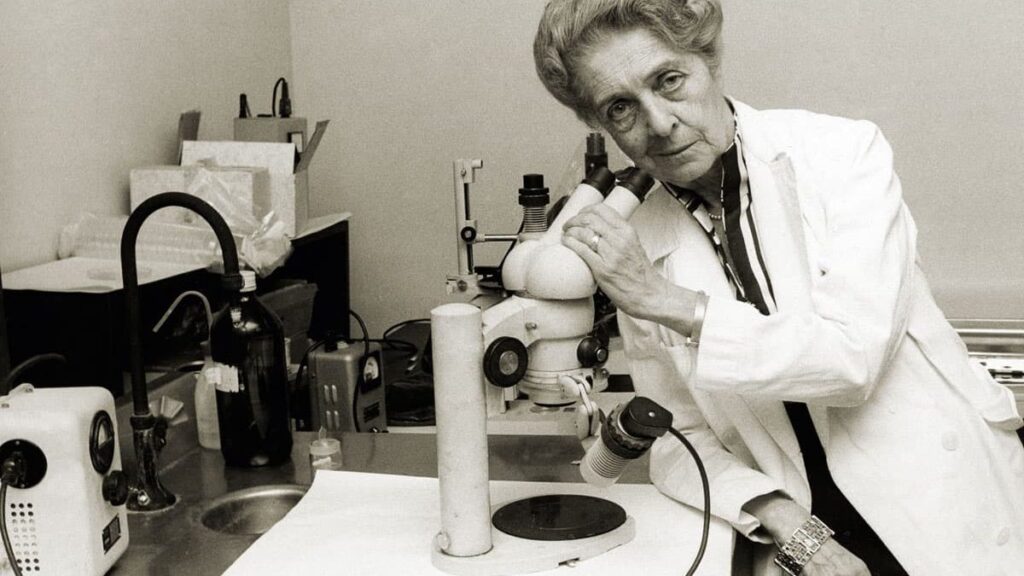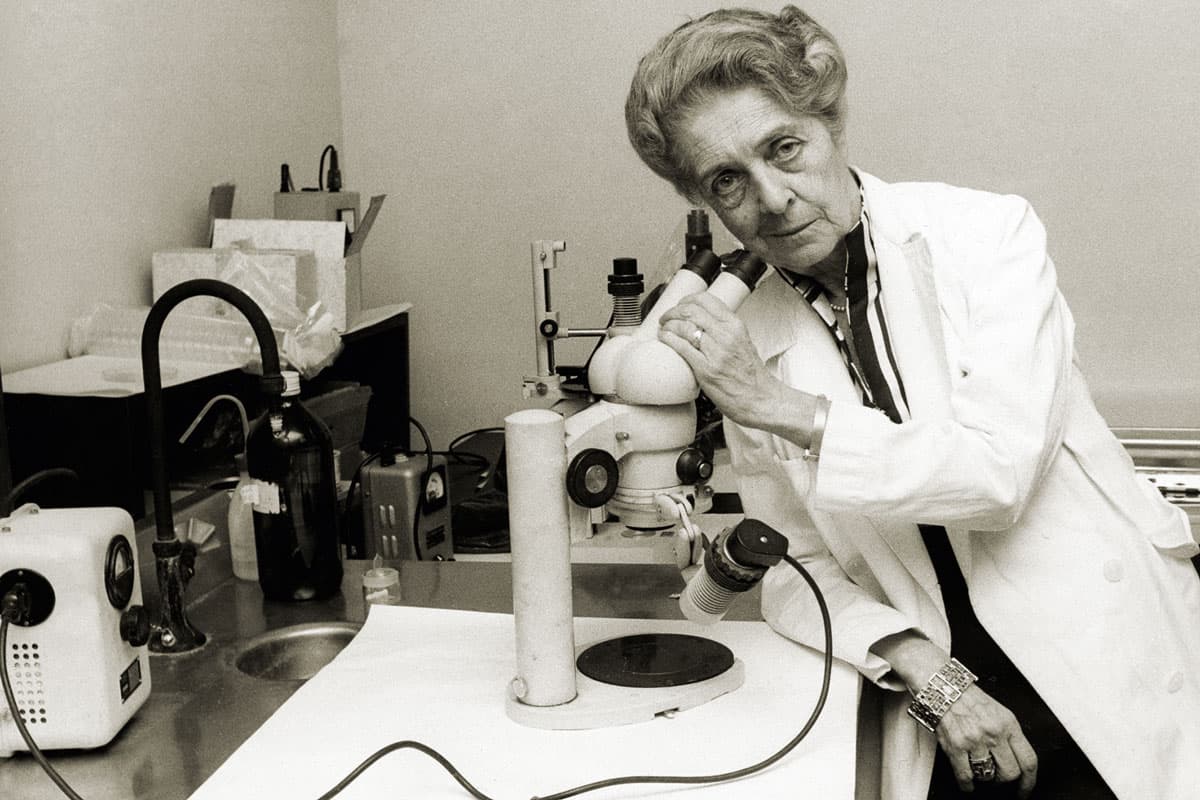Who was Rita Levi-Montalcini? A fertilized egg divides into two, then four, then eight, and countless other cells. While it does not show any features at first, it performs a miraculous thing by transforming into a skin cell, a liver cell, and a series of other cells that make up our bodies. The ability to control some of these activities in research on cellular growth and the development of unique characteristics in each tissue is one of the greatest developments in the history of medicine and has paved the way for many miraculous developments.
Rita Levi-Montalcini and Mussolini’s bigotry

Studies in developmental embryology in the 1940s led to the discovery of nerve growth factor, followed by epidermal factor and many other growth factors, as well as cytokines, including erythropoietin, which stimulate the proliferation of red blood cells (erythrocytes). Rita Levi-Montalcini, a clever and pleasant woman, was from a highly distinguished family of intellectuals, artists, architects, and mathematicians. Despite having an interest in writing since childhood, she became a physician. But her passion for discovering things never stopped. She expresses her passion for discovery in these words:
In 1936, Mussolini published the declaration “Manifesto per la Difesa della Razza,” signed by 10 Italian “scientists.” Following the declaration, a series of laws were enacted that banned the academic and professional careers of non-Ari Italian citizens. After working for a short time at a neurological institute I visited in Brussels, I returned to Turin with my family. Meanwhile, Belgium was on the verge of occupation by the German army in the spring of 1940.
We had two options in front of us: We would either move to America or stay here, regardless of the practices of the Aryan world. My family chose the second option. After this decision, I decided to establish a research laboratory in my bedroom at home. In this decision, Viktor Hamburger’s 1934 article on “The effect of the destruction of peripheral areas in chicken embryos” played a major role.
The bombing of Turin by the Anglo-American Air Force in 1941 forced us to leave and move to a village. I also re-established my small laboratory in the village house there and continued my work. In the autumn of 1943, the Italian army attacked Italy, forcing us to leave the village of Piedmont where we took refuge, and move to Florence. We lived there in secret until the war was over.
During our stay in Florence, I was in contact with many of my close friends and brave supporters of the “Partito di Azione” party. In August 1944, Anglo-American forces were trying to expel German occupants from Florence. At that time I was hired as a physician at the Anglo-American forces’ headquarters; I was working in a camp where refugees were brought to Florence from the areas where the war continued violently. When I was working as a nurse and doctor in this camp, where infectious epidemics and typhus swarmed, and there were a lot of deaths, every day I shared their pain and fear of death.
The war in Italy ended in May 1945. I returned to Turin with my family and resumed my academic post at the university. In the autumn of 1947, Viktor Hamburger invited me to work together to repeat our previous experiments on chicken embryos, which changed the course of my life.
Rita Levi-Montalcini, “Autobiography”, “The Nobel Prizes, Ed. Wilhelm Odelberg / Stockholm: Nobel Foundation 1987
Experiments on chicken, and mouse
When Levi-Montalcini was working on chicken embryos, she placed the mouse tumor cells on the cell wall of the chicken and saw that the nerve tissues of the chicken developed and multiplied remarkably. Nerve elements continued to reproduce in mouse tumors as if they were out of control and also began to form kidneys, thyroid glands, spleens, and other tissues from the nervous system of the chicken. As a result of a series of rigorous experiments, Levi-Montalcini and her assistants found that the mouse tumor circulated in the blood, causing the secretion of a small protein (peptide) that acts as a hormone, activating the formation and proliferation of target tissue (nerve cells). Levi-Montalcini called this peptide a “nerve growth factor”.
Her friend Dr. Stanley Cohen discovered the “epidermal growth factor” at about the same time. These growth-promoting hormones were discovered in highly irrelevant sites, namely cancerous tumors, snake venom, and salivary glands. Since the mouse nerve growth factor was also effective in chickens, there were many inter-species activities. Because biologically active peptide sequences tend to pass through the evolutionary process without being destroyed.
When a newborn mouse was given an antibody that influenced nerve growth factors in the saliva and the growth factor was inhibited, the development of the sympathetic nervous system stopped. Nerve cells, particularly those in the early stages of differentiation, are extremely sensitive to the nerve growth factor’s growth-promoting and controlling activities. Although there is activity in adult mouse tissues, it is not as intense as in newborn mouse tissues.
The description of cytokines
Growth factors are peptide hormones that affect cell division or differentiation by binding to receptors on the cell surfaces of target tissues and initiating signal transduction events. Many growth factors are variable factors that influence cell division in a wide variety of cell types. Some affect only certain cells.
Cytokines are the most unique group of growth factors. Primarily secreted by the white blood cells, cytokines stimulate both the secretory and cellular immune responses together with phagocytic cells (white blood cells that absorb pathogens, uric acid crystals, and many other harmful agents). Cytokines released by lymphocytes are called “lymphokines,” and cytokines released by monocytes or macrophages are called “monokines.”
A large family of cytokines is produced by various body cells. Many lymphokines are also known as “interleukin” (IL) because they are secreted by leukocytes and can affect the cellular responses of leukocytes. Interleukins are growth factors that specifically target cells of hematopoietic origin (which develop from bone marrow stem cells). Currently, the number of interleukins with 22 distinct functions identified is increasing.
- Epidermal Growth Factor (EGF)
- Platelet-Induced Growth Factor (PDGF)
- Fibroblast Growth Factors (FGFs)
- Beta Transforming Growth Factor (TGFs-β)
- Alpha Transforming Growth Factor (TGF-α)
- Erythropoietin (Epo)
- Insulin-like Growth Factor-1 (IGF-1)
- Insulin-like Growth Factor-2 (IGF-2)
- Interleukin-1 (IL-1)
- Interleukin-2 (IL-2)
- Interleukin-6 (IL-6)
- Interleukin-8 (IL-8)
- Tumor Necrosis Factor-Alpha (TNF-α)
- Tumor Necrosis Factor-Beta (TNF- β)
- Interferon-gamma (IFN-γ)
- Colony Stimulating Factors (CSFs)
- Brain Induced Neurotrophic Factor (BDNF)
Understanding the mechanisms of cytokines and growth factors on cell division sheds light on cancer treatment methods known as uncontrolled cell division. After chemotherapy, growth factors and cytokines are increasingly used in people with anemia, such as activating red blood cell proliferation. Thus, Rita Levi-Montalcini and Stanley Cohen discovered the first growth factor in 1952, the nerve growth factor.
Rita Levi-Montalcini quotes
“Above all, don’t fear difficult moments. The best comes from them.”
“I tell young people: Do not think of yourself, think of others. Think of the future that awaits you, think about what you can do and do not fear anything.”
“The body does whatever it wants. I am not my body; I am my mind.”
“Find first peace within yourself. Don’t eat too much. Keep your brain active. Love.”
“I should thank Mussolini for having declared me to be of an inferior race. This led me to the joy of working, not any more unfortunately, in university institutes but in a bedroom.”
“My experience in childhood and adolescence of the subordinate role played by the female in a society run entirely by men had convinced me that I was not cut out to be a wife.”
“Progress depends on our brain. The most important part of our brain, that which is neocortical, must be used to help others and not just to make discoveries.”
“At 100, I have a mind that is superior – thanks to experience – than when I was 20.”
“At 20, I realized that I could not possibly adjust to a feminine role as conceived by my father and asked him permission to engage in a professional career. In eight months I filled my gaps in Latin, Greek and mathematics, graduated from high school, and entered medical school in Turin.”
“If I had not been discriminated against or had not suffered persecution, I would never have received the Nobel Prize.”
“You’ve been thinking about something without willing to for a long time…Then, all of a sudden, the problem is opened to you in a flash and you suddenly see the answer.”
Sources:
- Levi-Montalcini, Rita, In Praise of Imperfection: My Life and Work.(Elogio dell’imperfezione) Basic Books, New York, 1988.
- Mastella: sì al procedimento su Storace”. la Repubblica. 17 October 2007.
- “Dispetto alla Montalcini al seggio”. La Repubblica. 14 April 2008.
- “The Nobel Prize in Physiology or Medicine 1986”. The Nobel Foundation.
- Yount, Lisa (1996). Twentieth Century Women Scientists. New York: Facts on File. ISBN 0-8160-3173-8.


